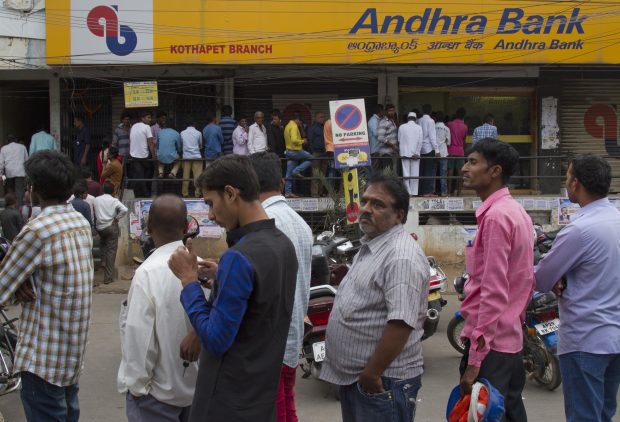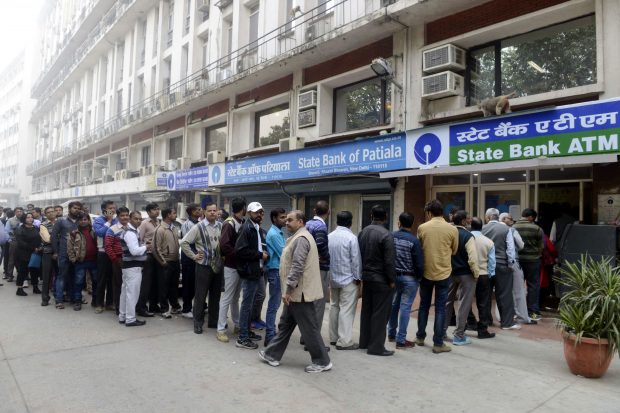Demonetisation of Currency in India

Indians stand in a queue outside an ATM to withdraw money in Hyderabad, India, Friday, Dec. 2, 2016. Indian Prime Minister Narendra Modi, in his Nov. 8 televised address, announced demonetization of India’s 500 and 1,000-rupee notes, which made up 86 percent of the country’s currency. People have been forced to stand in long queues to change banned notes and also to take out new currency from their accounts after severe limitations were imposed on withdrawal from banks and ATMs. (AP Photo/Mahesh Kumar A.)
Last year, the Indian Prime Minister, Narendra Modi gave an unscheduled live televised address to the nation on November 8 at 8.15 pm. He suddenly announced that high denomination currency notes, all of 86% currency in current circulation, will no longer be legal tenders after midnight.
The political circles and media went into a spin. Some called it financial emergency while others called it a big blunder attributing political motives to the big bang financial announcement.
The government claimed that the demonetisation was an effort to stem various issues. To stop counterfeiting of the current banknotes allegedly used for funding terrorism, as well as a crack-down on black money in the country. The move was described as an effort to reduce corruption, the use of drugs, and smuggling.
However, in the days following the demonetisation, banks and ATMs across the country faced severe cash shortages…and continued to result in hardship for the common man.
According to a newspaper report published in June last year, “As many as 250 out of every one million notes in circulation are fake, according to a study conducted by the Indian Statistical Institute. Typically, at any point in time, fake banknotes with a face value of Rs 400 crore are in circulation in the country. The study revealed that fake currency notes with a face value of Rs 70 crore are infused into the system every year, and law enforcement agencies are able to intercept only a third of them — a fact that is acknowledged by the agencies themselves.”
Counterfeited banknotes allegedly used for funding terrorism was not the only reason presented by the government. The Modi government has been looking at money laundering and the menace of parallel economy of black money. It has destroyed the very fabric of real economy and above all, morality in the younger generation.

(161202) — NEW DELHI, Dec. 2, 2016 (Xinhua) — People queue outside a bank to withdraw cash after the demonetization of currency notes of 500 and 1,000 Indian rupees in New Delhi, India, Dec. 1, 2016. (Xinhua/Stringer) (djj)
According to a report written by Arun Venkatraman in GQ webpage, “While most Indians seem to have forgotten, India has twice demonetised its largest currency notes in the past. First was in the pre-independence years in 1946, when the government demonetised both the Rs 1,000 and Rs 10,000 notes. New notes for these denominations weren’t reintroduced until almost a decade later in 1954. However, perhaps the instance that bears the most resemblance to the country’s present push came in 1978, when the Janata Party government (the ideological predecessor of the current BJP) demonetised the country’s three largest currency denominations – Rs 1,000, Rs 5,000 and Rs 10,000 to weed out increasing fake currency and black money.”
In India, it is a well-known fact that black money is largely generated during the elections and in the real estate sector. A clear nexus between the politicians, the industrial houses and the bureaucracy is formidable. The black money that stayed outside the banking system has been invested in the real estate sector and gold.
This spiralled the cost of residential housing into an unrealistic zone. A normal, honest, salaried young Indian would not be able to afford to buy his or her own house in one life time.
Over the years, the rich got richer and the poor became poorer. The generation of jobs dwindled.
Mahatma Gandhi said, “The world has enough for everyone’s need, but not enough for everyone’s greed.” It is unfortunate that Indians have forgotten this adage. They increasingly clamour for more and more in a rapidly modernising ancient society heading towards a westernised consumerism.
Flushing out black money from the banking system by force may not really be a permanent fix…it is soon to return into circulation. For the moment, what Indians need to understand is that morality of living a simple and honest life is more important.
Prime Minister Modi has an arduous task at hand. First the system will need to be fixed and then a long haul for inculcating honesty in the coming generation of young Indian. It is any body’s guess if he will be able to succeed.
The members of powerful and rich political parties, including the Communists, sitting in the Indian Parliament, make loud noises and want to negate the efforts of the government to purge the black money from Indian banking system. Most may have their own interests within the corporate world and the real estate business.
For India, it will be unfortunate if the negative forces win and the effort of Prime Minister comes to naught in the long term. The poor may continue to vote and support the efforts of Prime Minister Modi, since they are the ones who have suffered for decades.





















































